Sharing is caring!
Betta fish come in many different colors and color patterns, some more common than others. These color patterns can be found on bettas of all different fin and body styles. Let’s go through the different colors and patterns so that you’ll be able to recognize and identify them yourself.
The most common betta color types
Starting in the late 1800’s bettas began to be bred for their appearances. While this was done to obtain varying fin types, new colors and patterns were also introduced.
It became such a hobby that in 1966 Dr. Gene Lucas founded the International Betta Congress (IBC) in order to set standards and guidelines, which we follow today. These standards were followed in this article.
Bi-Color Betta
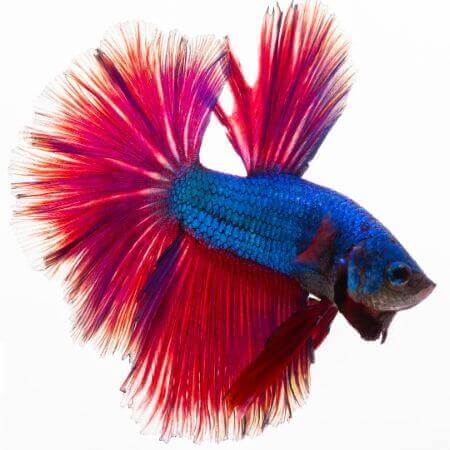
Bicolor bettas will consist of two colors. They should have a distinct color separation between body and fin.
There are resources out there that claim any betta consisting of two colors is a bicolor. While the name “bi” may imply this, the standards set by the International Betta Congress states that the colors must be separated by body and fin. Meaning, the body is one color and the fins are another.
Other sites that I’ve read ignore the body color and apply this two-color rule only to its fins. However, this color pattern would fall under the subgroup “multicolor” of the patterned bettas.
Butterfly Betta
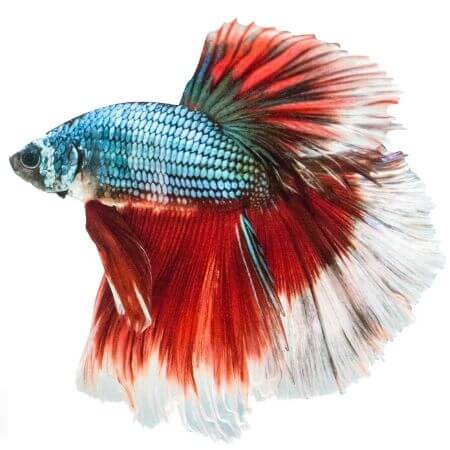
Butterfly bettas will have 2-3 bands of color. The body color will typically continue into the fins. The color transitions should not bleed into each other though.
The butterfly is a patterned betta of which there are two different styles, bicolor and multicolor. The term bicolor, when applied to butterfly bettas, is referring only to its fins.
The fins of the bicolor will have two bands of color with a ratio of 50/50. The fins of the multicolor will have three bands of color with each band being 1/3 of its fins. These bands should be of contrasting colors and should form a clean oval pattern.
Marble Betta
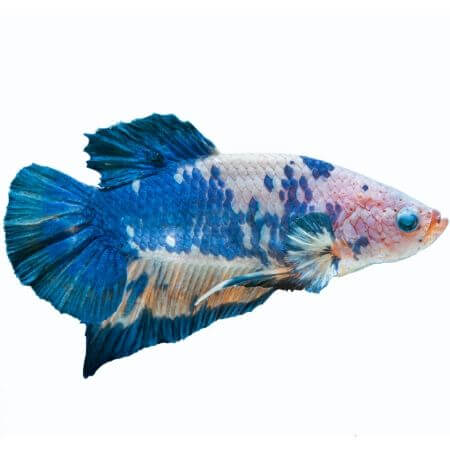
Marble bettas will generally be a dark fish that have lighter color blotches of color loss. The blotches should be included on the fins and be around a ratio of 50/50.
Marble bettas are a subgroup of patterned bettas. Although under the same class as the butterfly betta, marble bettas will lack the traditional banding. Their patterns must have a marbling effect. Although a ratio of 50/50 is desired, being overly symmetrical is not. High contrast between the colors must exist to be marbled.
Marble types
- Traditional
- Colored
- Red
Koi Betta
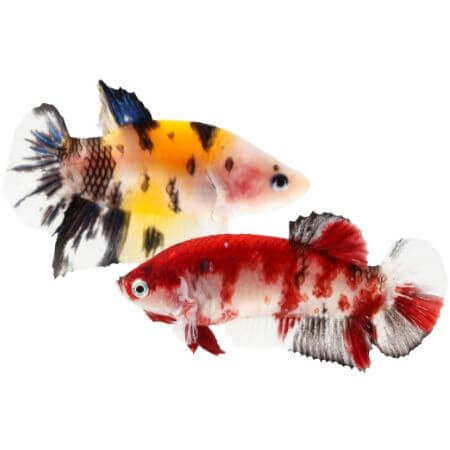
Koi bettas are the same as marble bettas expect that they will have more than two colors.
Koi isn’t a technical classification of color so these patterns would still fall under the marble subgroup. The difference would be in their subcategory type. the “koi” fall under the “colored” instead of the “traditional”.
Grizzle Betta
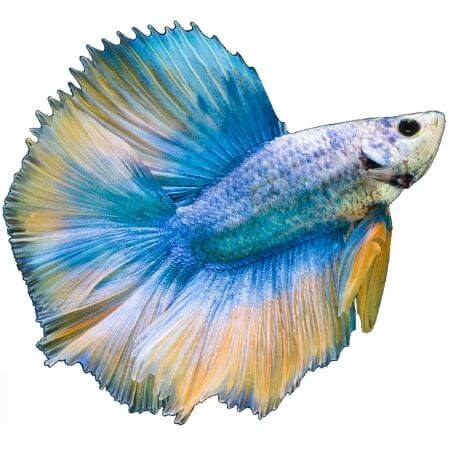
Grizzle bettas will have iridescent spotting on an opaque or pastel body. Two iridescent colors will have the appearance of being “painted” on the fins with brush strokes. The grizzle betta is another type of patterned betta.
The grizzle effect must be present on all fins. The body should also have 2 different shades of iridescent color. Any presence of black or red would be considered a fault. Depending on how much of these colors are present, the betta may have to be considered a marble or multicolored.
Dragon Betta
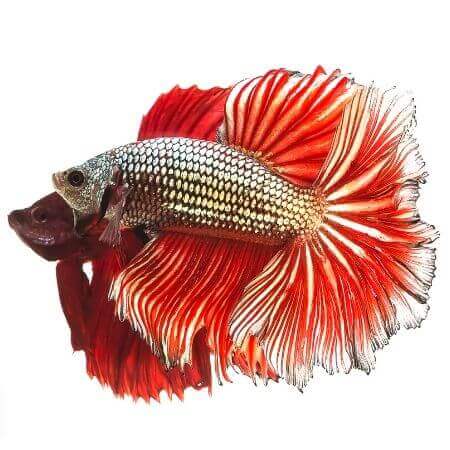
Dragon bettas will have metallic or white scales edged in black. These scales will resemble the scales of lizard (or dragon). Fins will have a strong base color.
There is not a traditional class set for dragon bettas, at least not yet since these are “newer”. They will typically be shown as bicolor or multicolored. Although the body has a metallic appearance, it is not present within the fins which is my assumption why it wouldn’t be considered a true metallic.
Metallic Betta
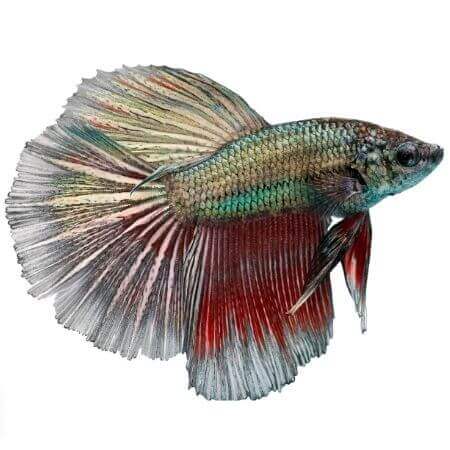
Metallic bettas, such as the Copper, will have a shiny iridescent layer over their base color. This layer will reflect light in a way that gives the appearance of metal.
The metallic effect is caused by yellow-reflecting chromatophores which cover the fins and body. Metallics are comprised of eight different recognized color types.
Metallic color types
- Copper
- Teal
- Green
- Yellow or Gold
- Clear
- Orange
- Pastel
- Opaque
Mask & Piebald Bettas
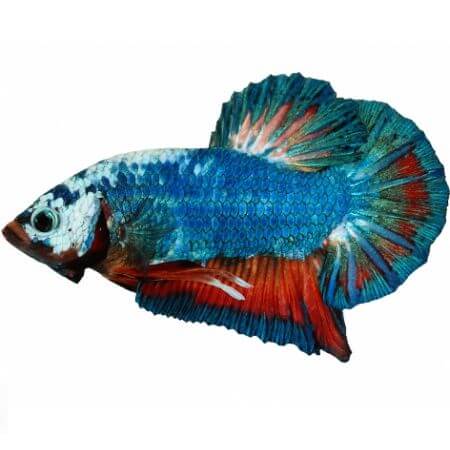
These will have heads that are a different color than their bodies. Piebalds will have “fleshy” colored heads and Masks will have heads darker than their bodies.
A 3rd option is the full mask, which will have black heads. However, when it comes to judging metallics there is also something called “unmasked”. Since these are being judged on their metallic appearance, the lack of its presence on the head would be judged separately. Partial masking in either scenario is undesirable.
Cambodian Betta
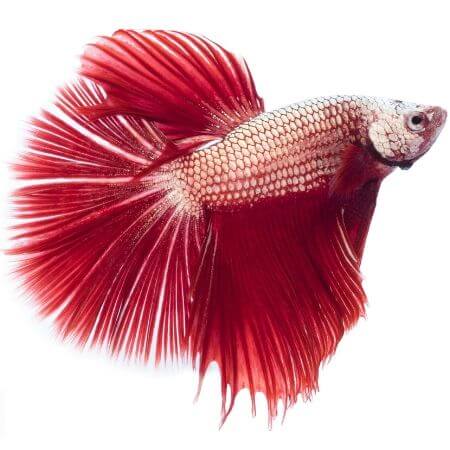
A Cambodian is a bi-color betta of specific color patterns. The body will have a “fleshy” color while the fins will either be red, blue, or green.
Although Cambodian bettas can be a variety of colors, the traditional judgment is for pale bodies and red fins. Any other color would fall under the sub-type “Cambodian AOC (any other color)”.
Melano & Black Bettas
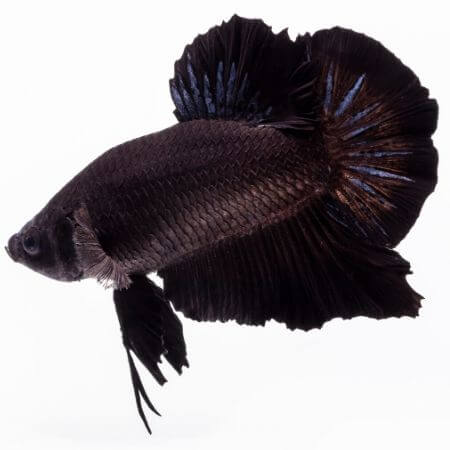
Melano, Black Lace, and Super Black all fall under this category. Black bettas with any iridescence, typically on the ends of their fins, are Black Lace. Melano bettas are all black but lighter, while Super Blacks are all deep black.
Black colored bettas fall under the category of non-iridescent type black.
Black betta color types
- True Black
- Black Lace
- Melano
A true black betta will have a deep dark black coloring but will also have some iridescence due to the breeding with steel blue metallic females.
Black lace bettas are all black except for the rays of their fins. The fin rays will have translucent webbing.
Melano bettas are a combination of both true blacks and black lace. These will be entirely black, like the true blacks, but will not have any presence of iridescence.
Other color variations
The list goes on. There are many more colors not mentioned previously, such as single-color bettas. Here is the full list.
Single colored bettas
- Black (true black, black lace, and melano)
- Red
- Blue
- Steel Blue
- Turquoise
- Green (true green and common green)
- Orange
- Yellow
- Clear (cellophane and albino)
- Pastels (pastel blue, pastel green, and pastel white
- Opaques (opaque blue, opaque green, and opaque white)
Bi-colored bettas
- Chocolate
- Cambodian
- Any other 2 color combination not previously given a common name
Patterned bettas
- Butterfly
- Marble (traditional, colored, red, and koi)
- Multicolor
- Grizzle
Metallic bettas
- Copper or steel blue
- Yellow or Gold
- Teal
- Green
- Clear
- Orange
- Pastel (blue, green, and white)
- Opaque (blue, green, and white)
Quick reference infographic

Share this image on your site
Feel free to include this infographic on your website. Attribution is required. Simply copy and paste the code below onto your site.
Sharing is caring!





